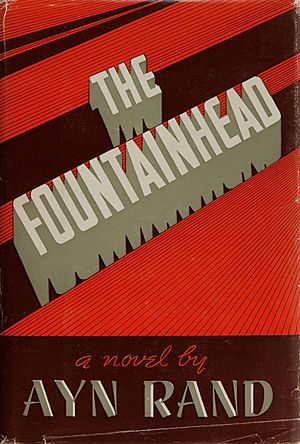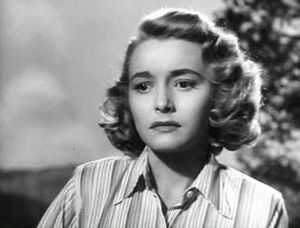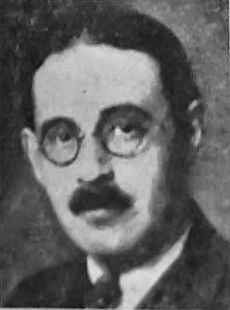The Fountainhead facts for kids

Cover of the first edition
|
|
| Author | Ayn Rand |
|---|---|
| Country | United States |
| Language | English |
| Genre | Philosophical fiction |
| Publisher | Bobbs Merrill |
|
Publication date
|
1943 |
| Pages | 753 (1st edition) |
| OCLC | 300033023 |
The Fountainhead is a famous book written in 1943 by an author named Ayn Rand. It was her first big success. The story is about a young architect named Howard Roark. He loves to create new and different buildings. But he has to fight against old ways of thinking in the world of architecture. People don't want new ideas.
Roark believes in being true to himself and his ideas. He doesn't want to copy others. This is a big part of Rand's ideas, which are called Objectivism. She believed that being an individual and thinking for yourself is better than just following the crowd. The book also shows how people can achieve great things, like building tall skyscrapers.
Many publishers first said no to the book. But one editor at the Bobbs-Merrill Company took a chance. At first, not many copies were sold. But people started talking about it, and it became a bestseller. Millions of copies have been sold around the world. The book became very popular with architects, business owners, and people who believe in conservative or libertarian ideas.
The Fountainhead has also been made into other things. There was a comic strip version in newspapers in 1945. A movie was made in 1949. Ayn Rand herself wrote the movie script. Later, a play was created in 2014.
Contents
Main Characters
Howard Roark

Ayn Rand wrote her books to show what she thought an ideal person would be like. Howard Roark is the main character in The Fountainhead. Rand felt he was the first time she truly showed her ideal man. Roark shows Rand's ideas about being independent and having strong personal values.
The character of Roark was partly inspired by a real American architect named Frank Lloyd Wright.
Peter Keating
Peter Keating is very different from Roark. He always tries to fit in and do what others expect. When he was young, he wanted to be a painter. But his mother pushed him to become an architect instead. He always makes choices based on what will help him get ahead. He marries Dominique, not because he loves her, but because she is beautiful and well-connected. By the time he is older, Keating is not happy with his life.
Dominique Francon

Dominique Francon is the main female character in The Fountainhead. Ayn Rand described her as the perfect woman for someone like Howard Roark. Rand also said Dominique was like herself when she was in a bad mood.
Gail Wynand
Gail Wynand is a very rich newspaper owner. He grew up poor in New York City. He became powerful by controlling many newspapers. Wynand is smart and strong like Roark. But his weakness is that he tries to please public opinion. This eventually leads to his downfall.
Ellsworth Toohey

Ellsworth Toohey is the main bad guy in the story. He is a socialist and represents the idea of people working together in a way that takes away individual freedom. Toohey pretends to speak for everyone. But what he really wants is to have power over other people.
Adaptations of the Story
Film
In 1949, a movie based on the book was released by Warner Bros. Gary Cooper played Howard Roark. Patricia Neal played Dominique Francon. Ayn Rand herself wrote the movie script. The film was directed by King Vidor.
Many critics did not like the movie. They wrote negative reviews in newspapers and magazines. However, the movie helped the book sell more copies.
Later, Ayn Rand said she did not like the movie. She felt it was not edited well and the acting was not good. She said she would only sell movie rights to her books if she could choose the director and screenwriter.
Some filmmakers have wanted to make new movies of The Fountainhead. But none of these projects have started filming yet.
Play
A Dutch theater company created a play based on the book in 2014. It was shown at the Holland Festival. The play was directed by Ivo van Hove. Ramsey Nasr played Howard Roark. Halina Reijn played Dominique Francon. The play was about four hours long. It used video screens to show close-ups of the actors and Roark's drawings.
The play was shown in many cities in Europe. Most reviews in Europe were positive. But when the play came to the United States, many American critics did not like it as much. Some said it was too long.
Television
The book was made into a TV show in Pakistan in the 1970s. It was called Teesra Kinara.
The story was also made fun of in a cartoon show called Mighty Mouse: The New Adventures. It was also parodied in an episode of The Simpsons.
Other Adaptations
In 1944, a shorter version of the book was made for soldiers. Ayn Rand was not happy about this because she did not approve the text.
In 1945, a comic strip version of the novel was made for newspapers. Ayn Rand made sure she could check the editing and the drawings. This comic strip ran in over 35 newspapers.
Related pages
Images for kids
-
Rand's descriptions of Roark's buildings were inspired by the work of Frank Lloyd Wright, such as Fallingwater.
-
Gary Cooper played Howard Roark in the film adaptation.
See also
 In Spanish: El manantial para niños
In Spanish: El manantial para niños




